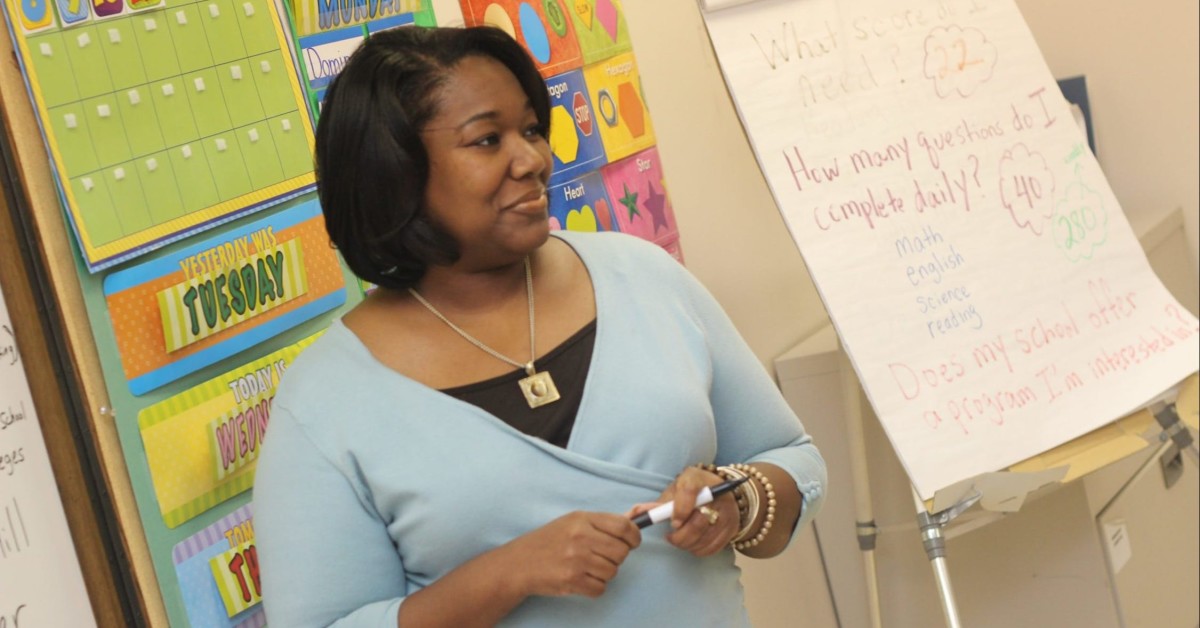
Are Teacher Residency Programs Worth It?
If you're looking to quickly (and inexpensively) earn your MAT [...]
The Bay Area teacher shortage has become so bad that the Unified School District Superintendent herself taught science at the beginning of the 2021 school year. This comes in spite of the fact that the United States Bureau of Labor Statistics (BLS) lists San Francisco, Oakland, and Hayward as one of the highest paying metropolitan areas for teachers in the country, with an annual mean wage of $92,380.
San Francisco teachers cite the ongoing COVID-19 pandemic as one reason why they are hesitant to return to their classrooms, but the state shortage is bad seperate from current public health matters. In fact, in 2019 there were fewer teachers than before the recession.
A popular way to combat shortages is through accelerated, experience-based teacher residency programs, where one can gain valuable classroom experience while earning a degree and teaching credential in just one year. Plus, these residencies frequently come with scholarships or teaching stipends designed to help reduce students’ costs. According to the most recent statistics from the Learning Policy Institute, San Francisco’s flagship teacher residency program produced over 150 new teachers. Of those, 80 percent were still teaching in the district after five years, compared to 38 percent of all other hires from traditional teacher training programs.
You may be asking: how do I enter a teacher residency program in San Francisco? This article covers addresses everything you need, including:
Teacher residencies are offered through partnerships between universities or nonprofit educational organizations and schools/school districts, and are modelled after medical residency programs. Instead of holding off teaching in-person toward the end of—or after—graduate school (as traditional teacher training programs do), student teachers spend a whole school year in the classroom, often logging around 1,000 hours of teaching, under the guidance of a mentor teacher.
Typically, residencies consist of either a full or half-day teaching in the classroom—with coursework done at night and on weekends. Student teachers apply the lessons learned through their master’s degree coursework on a daily basis, while receiving feedback from their mentoring teachers throughout the academic year. In many cases, student teachers work in high-need public or charter schools, and commit to working full-time for a specific number of years after their residencies.
Though there are exceptions, most residencies confer either a master’s degree—typically a Master of Arts in Teaching (MAT)—or similar graduate education degree. Though less common, bachelor’s-level residencies are offered through some programs.
Residencies typically lead to teaching positions in schools in underserved communities. According to the National Center for Teacher Residencies (NCTR), Title I public schools (federally funding for schools serving low-income students) employ more than 90 percent of graduates from teacher residency programs (the NCTR notes that 94 percent of residents feel prepared for these high-needs environments after graduating). In these schools, oftentimes the teacher turnover rate is abysmal—50 percent higher than average according to the Learning Policy Institute. Teacher residency programs help address this attrition: 86 percent of graduates stayed in their residency schools for at least three years, according to the NCTR. (To be fair, three years is the average amount of time you must teach at your residency school to keep your stipend.)
The main San Francisco teacher residency program launched in 2010 as a partnership between the San Francisco Unified School District (SFUSD), University of San Francisco (USF), Stanford University, and the local teachers’ union, United Educators of San Francisco. Notably, USF does not currently offer a residency program, though it may at some point in the future.
Early research suggests that teacher residencies increase the diversity of people entering this profession and what they are specializing in; improve teacher retention rates; produce effective teachers; and more.
Traditionally, residency programs attract more students of color. According to the Learning Policy Institute study, students of color made up 66% of residency graduates, whereas only 49 percent of SFUSD teachers were people of color. This is consistent with the overall numbers for residency programs. In its 2020 report, the National Center for Teacher Residencies (NCTR) said that more than 60% of teaching residents were people of color—40 percent higher than those entering from traditional programs. Additionally, the report found that over 20% of residents specialize in STEM subjects.
High retention rates benefit schools and students. The Learning Policy Institute found that teacher experience corresponds with “student achievement gains”, especially in the early years of a teacher’s career. Residents also can also have a positive impact on their mentor teachers, who tend to increase their teacher effectiveness score (TES), according to a Glass Frog Solutions paper.
| University and Program Name | Learn More |
|
New York University:
Master of Arts in Teaching
|
|
|
Merrimack College:
Master of Education in Teacher Education
|
San Francisco schools with residency programs, or programs that closely fit the residency model, include:
According to its website, “Marshall Street Initiatives is a coalition of educators working to systematically improve opportunities for students across the country.” The residency program partners with Bay Area schools. Residents work towards a California Preliminary Single Subject Teaching Credential in subjects like English, math, chemistry, and physics. Like many university programs, Marshall Street offers a living stipend ($18,000), making the $15,000 tuition more palatable. Unlike many university programs, you’re only allowed to pursue a Master’s in Education after completing your residency.
NYU partners with the SFUSD to prepare teachers to take on positions in urban schools. The program goal is to reduce “the predictability factors that have historically correlated with success so that every student who enrolls in an SFUSD school will graduate prepared to succeed in college, career, and life.”
Students complete a 30 credit MAT, which requires around 15 hours per week of online classes. Additionally, they spend around 40 hours per week with a mentor teacher in a partner school. They start by working with individual students and eventually teach a maximum of three periods per day. In return for a two-year postgraduate teaching commitment, students receive a “tuition subsidy and stipend or wage from partner school.”
Though not a university, The New Teacher Program directly partners with the SFUSD to offer a residency-like pathway. Cohort members receive individual and group training with their mentor teachers and complete “a year of teaching, coaching, and community-building.” It’s designed to help them “forge relationships in their schools and develop a rigorous, culturally relevant curriculum that will prepare students to live, thrive, and succeed in San Francisco and beyond.”
Students don’t earn a degree during the program. Instead, they work towards an initial teaching credential. Coursework includes “content-specific mini-courses” in the summer before school starts, plus “online modules specific to the credential area” during the year. Students choose from three credential areas: Multiple Subject (K-5), Multiple Subject (K-5) with a Bilingual Spanish Authorization, and Education Specialist, Mild and Moderate Special Education (K-12). The program itself costs $5,000, but you don’t need to pay for it up front; instead, the institution takes chunks out of your paycheck in ten monthly installments.
SFSU offers a teacher fellowship to “STEM majors and credential students interested in being K-12 teachers” through its Center for Science and Mathematics Education. It’s not quite a residency; you’ll also need to complete your undergraduate degree or credential requirements. Additionally, students only work 45 hours in a classroom. Fellows receive a stipend ($300 to $1,500) if they commit to performing community service. Other perks of this program include the opportunity for a paid summer internship and reimbursements for exam and application fees.
The Graduate School of Education’s mission is to “cultivate teacher leaders who share a set of core values that includes a commitment to social justice, an understanding of the strengths and needs of a diverse student population, and a dedication to equity and excellence for all students.” Grad students at Stanford, a Bay Area school, can complete Stanford Teacher Education Program (STEP), a one-year Master of Arts and teaching credential program. It has many elements of traditional residency programs. Students are assigned multiple semester-long placements in a school and learn from working teachers—and can choose either an elementary or secondary education track.
Stanford partners with the San Francisco Urban Teacher Residency (SFUTR), which follows the traditional residency model and comes with a stipend. This program is only available to STEP students pursuing math and science, and willing to teach in a public school for three years after graduation.
Stanford has a robust loan forgiveness program. Program graduates who agree to “work in a public school or an underserved private school in the United States” don’t need to pay loans, which halve after two years and disappear after four. Prospective teachers can also secure a STEP fellowship, which can reach $25,000. According to the program website, 85% to 90% of candidates meet eligibility requirements each year.
General requirements for residency programs include a bachelor’s degree, often in a relevant subject. You may need to complete prerequisite courses and prove that you had a good undergraduate GPA—3.0 is the standard. Many institutions request that applicants not have previous teaching experience, as they’ll typically be earning an initial certification.
Teacher residencies typically require students to complete an aptitude test. In California, the California Basic Educational Skills Test (CBEST) is common. Other pathways include the California Subject Examinations for Teachers (CSET), which covers multiple subjects. Or, the English and math sections in the California State University (CSU) Early Assessment Program (EAP), especially if you want to attend a state university. Check to see if your chosen program has a preference. The New Teacher Program accepts several tests. NYU Steinhardt is less California-focused and asks for either the Graduate Record Examinations (GRE) or Miller Analogies Test (MAT).
Coursework includes pedagogy and teaching theory but ultimately depends on your chosen track. For instance, Stanford students pursuing a secondary certification need to specialize in a subject area like math, history and social science, English, science, or foreign language.
California teacher salaries are among the best in the country. According to the US Bureau of Labor Statistics, California secondary school teachers earn an annual mean wage of $86,900, second only to New York. Elementary school teachers earn the most nationally: $85,110. Bay Area teachers are especially well-paid.
Experienced teachers with advanced education typically earn more than younger, less educated teachers. For the 2019-20 school year, fully credentialed SFUSD K-12 teachers with a bachelor’s degree and one year of experience earned $63,458, while those with ten years of experience earned $71,408 at salary schedule one. Salary schedule three teachers earned $69,111 and $88,732 at one and ten years respectively.
Oakland uses a step schedule that values experience and education. In 2021, 10 month K-12 teachers at the lowest step, meaning those with a degree and no experience, earned $57,095.64. Depending on your education, you may not need to start at the lowest step. The highest step is 32 and is for teachers who have extensive additional education—they earned $97,980.20.
(Last Updated on February 26, 2024)
Questions or feedback? Email editor@noodle.com

If you're looking to quickly (and inexpensively) earn your MAT [...]

The road to becoming a licensed pharmacist requires years of [...]

The beauty of online teacher residency programs is that after [...]

Pharmacists may be the unsung heroes of patient healthcare, providing [...]

If you enroll in a teacher residency program in California, [...]
Categorized as: Elementary Education, Secondary Education, Education & Teaching